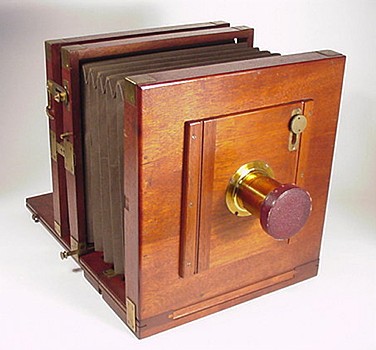
Mahogany Glass Plate Camera

This tailboard style wood-bodied camera is constructed of mahogany and brass and fitted with a heavy canvas bellows. In a tailboard camera, the camera front is fixed to the baseboard. The bellows section can be collapsed against the front board and then a rear section of baseboard can be folded up, thus protecting the ground glass viewing screen, and making a compact package for transportation and storage.
This is a full-plate camera. Full plate refers to the image size, which is 6 1/2 by 8 1/2 inches.
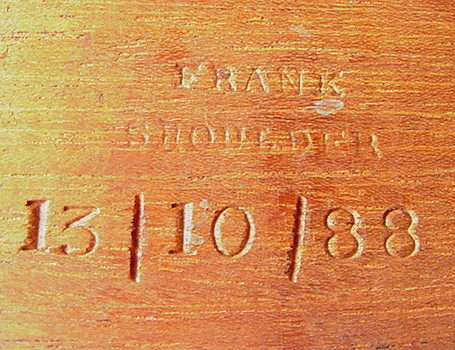
It may seem strange with our present day obsession with advertising, marketing and brand names that many cameras of the 1800s did not identify the name of the manufacturer. When a camera was marked, this was as likely the name of the seller as that of the maker.
This camera does not have external markings, but a name and date is stamped into the back side of the lens board. The stamping reads: Frank Shoulder 13/10/88. This mark is a bit unusual because other than patent dates, it was not at all common for a camera to be dated. I've considered whether this stamp could have been the camera owner's. This seems unlikely, but it is a possibility if the photographer had access to a wood stamping set. This mark could have been made by the person who fit the lens to the camera, who may also have been the seller, or this may be the mark of the maker.
I have not been able to locate information on Frank Shoulder, but the good news is I can date the camera to ca. 1888. And certainly, the camera design, materials and workmanship are consistent with that period. The person I bought this camera from had purchased it in Glasgow, Scotland.
If you have information about Frank Shoulder, or this or a similar camera, I would appreciate hearing from you.
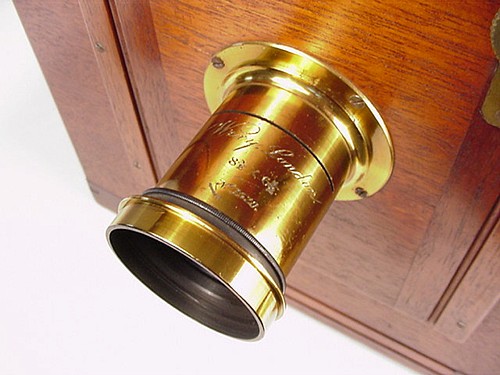
This Wray London 8 1/2 x 6 1/2 brass-bound lens is slotted for Waterhouse stops. It carries serial number 1529. The original brass finish has a nice patina, and the glass is clean and clear.
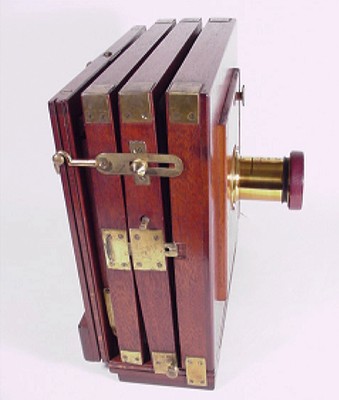
Folded, the tailboard design makes a compact, manageable package. But this is still a large and heavy camera, so a carrying strap would have been helpful.
Notice the massive brass hook that clips the tailboard in place. Also notice that the corners of the wooden frames are bound in brass. This form of construction, somewhat more expensive to produce than unbound corners was thought to give the camera greater durability, rigidity and strength.
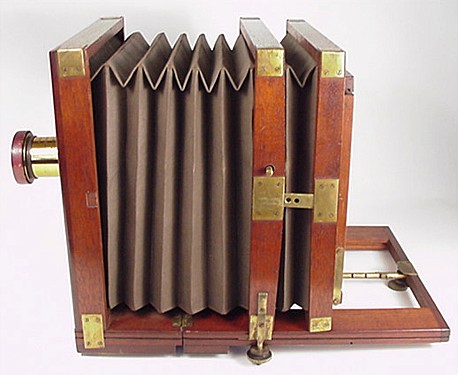
The front board does not really tip forward, just a hasty wide-angle digital photo. This camera back can be tilted around the horizontal axis for perspective control. This is why the camera has three sections.
The front board is fixed to the baseboard. It holds the lens and is attached to the bellows.
The center frame is not attached to the bellows. Notice a round nut below the center frame. The nut clamps the sliding center frame to the baseboard. By sliding the center frame back and forth along the baseboard the photographer adjusts the focus.
The third section, the camera back, is attached to the rear of the bellows. The back is attached to the center frame by two strips of brass, one on each side. The brass strips have holes that serve to lock the back a fixed distance from the center frame. Positioning the back farther away from the center frame gives the back greater clearance allowing a greater angle of tilt. A nut on the camera's opposite side locks the back and center frame together.
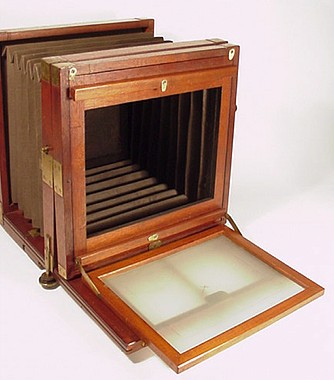
To take a photograph, a glass plate holder is set against the camera back. To do this the ground glass viewing screen is hinged out of the way.
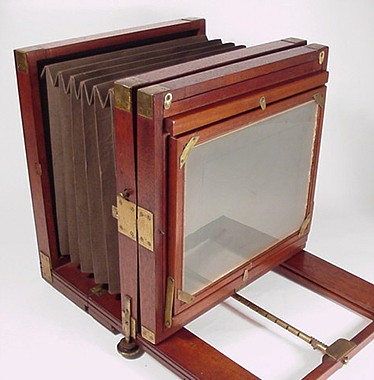
The ground glass screen is used for composition and focus. To view the scene on the ground glass a photographer would place a dark cloth over the camera back to shield the dim screen image from extraneous light.
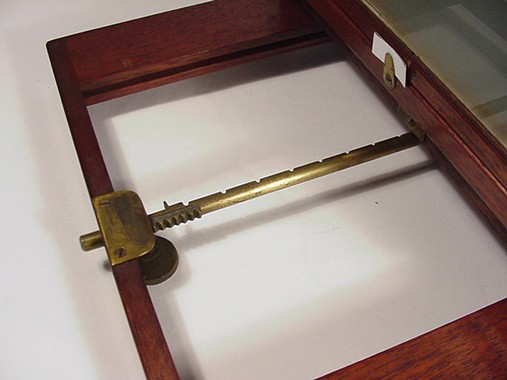
Before I describe the fine focus mechanism, I should point out the piece of white paper seen underneath the ground glass frame latch. I did not intend to include it in this photo, but it does give me an opportunity to get on my soapbox for a moment.
Over time, wood will shrink. Because of this, the latch no longer presses firmly against the ground glass frame. The piece of paper is all I need to prevent the frame from slipping off the back, and possibly breaking the glass — which it has tried to do a number of times. I could have removed the latch, bent it a bit, replaced it, and that may also have solved the problem. But then it would gouge the wood with its bent tip and may not have been all that effective.
Back to the fine focus, notice the brass rod with its notches and gear teeth. Beneath the rod, underneath the camera is a round knob. The knob is geared to the rod gear rack. Turning the knob causes the camera's center frame to move back and forth. See the next image for another view of this mechanism.
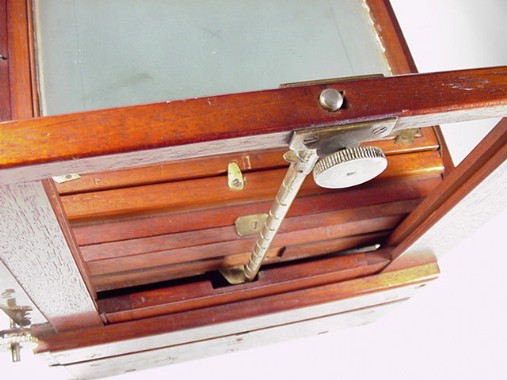
The fine-focus adjustment can be more clearly seen in this photo underneath the camera. At the forward end of the focusing rod notice a tongue of brass slipped into one of the rod's notches. This brass tongue can be slid left and right, and it is controlled by another rod that protrudes from the side of the camera. When the tongue is positioned left it does not engage the focus rod, so the center frame can be moved freely along the baseboard. The photographer will slide the center frame until the ground glass image appears sharp. Then by pressing the side rod in, the tongue will engage the focus rod. The rod's wheel can be turned, causing the center frame to move in smooth fine increments to finely adjust image sharpness.
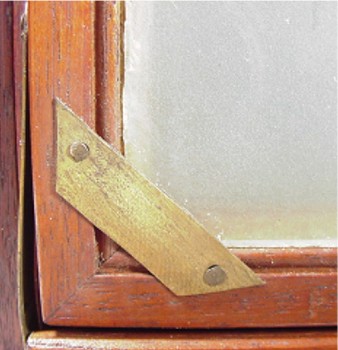
This hardware detail conveys the hand-built quality of early cameras.
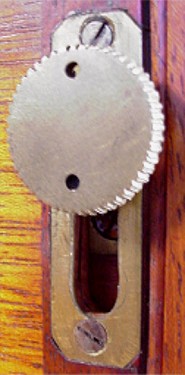 |
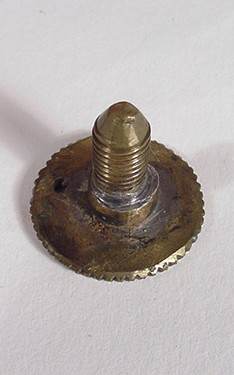 |
These images of the lens panel's rise and fall locking screw clearly show the handwork and skill that went into making early cameras. The screw has a finished appearance as seen in the image on the left. The underside of the screw reveals a multitude of tool marks and a crudeness rarely seen in our mass-production world. Notice that the screw, which today would be machined from one piece of metal was constructed of two pieces soldered together.
Nice job. Aren't old cameras great?

|
Page created March 3, 2002;
updated December 20, 2020 |